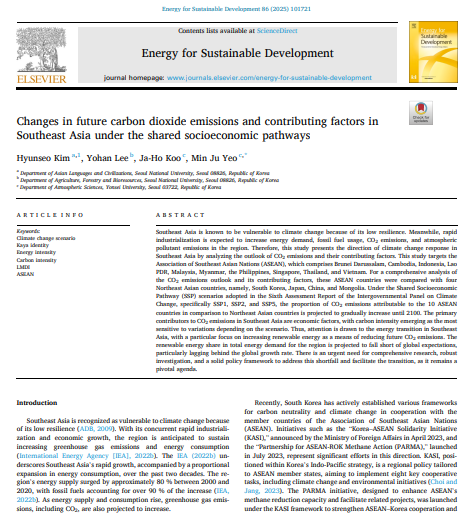
Keyword(s)
Author(s)
Hyunseo Kim, Yohan Lee, Ja-Ho Koo, Min Ju Yeo
Country(ies)
Publisher
Published Date
Access
DOI
1. Department of Asian Languages and Civilizations, Seoul National University, Seoul 08826, Republic of Korea
2. Department of Agriculture, Forestry and Bioresources, Seoul National University, Seoul 08826, Republic of Korea
3. Department of Atmospheric Sciences, Yonsei University, Seoul 03722, Republic of Korea
Southeast Asia is known to be vulnerable to climate change because of its low resilience. Meanwhile, rapid industrialization is expected to increase energy demand, fossil fuel usage, CO2 emissions, and atmospheric pollutant emissions in the region. Therefore, this study presents the direction of climate change response in Southeast Asia by analyzing the outlook of CO2 emissions and their contributing factors. This study targets the Association of Southeast Asian Nations (ASEAN), which comprises Brunei Darussalam, Cambodia, Indonesia, Lao PDR, Malaysia, Myanmar, the Philippines, Singapore, Thailand, and Vietnam. For a comprehensive analysis of the CO2 emissions outlook and its contributing factors, these ASEAN countries were compared with four Northeast Asian countries, namely, South Korea, Japan, China, and Mongolia. Under the Shared Socioeconomic Pathway (SSP) scenarios adopted in the Sixth Assessment Report of the Intergovernmental Panel on Climate Change, specifically SSP1, SSP2, and SSP5, the proportion of CO2 emissions attributable to the 10 ASEAN countries in comparison to Northeast Asian countries is projected to gradually increase until 2100. The primary contributors to CO2 emissions in Southeast Asia are economic factors, with carbon intensity emerging as the most sensitive to variations depending on the scenario. Thus, attention is drawn to the energy transition in Southeast Asia, with a particular focus on increasing renewable energy as a means of reducing future CO2 emissions. The renewable energy share in total energy demand for the region is projected to fall short of global expectations, particularly lagging behind the global growth rate. There is an urgent need for comprehensive research, robust investigation, and a solid policy framework to address this shortfall and facilitate the transition, as it remains a pivotal agenda.